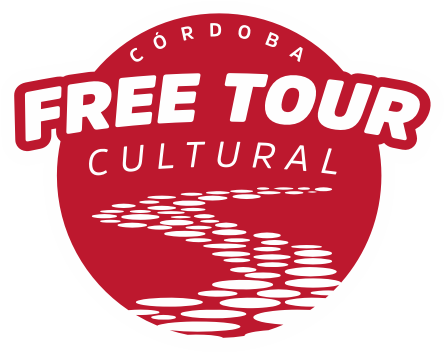Whenever we travel to a city we’ve never visited, questions inevitably arise: Where to eat? Where to park? What will the weather be like? And above all—why we’re here reading this blog—what can we see? What’s worth visiting?
It’s true that Córdoba isn’t especially large. We Cordobans say our city is quite “compact.” Everything’s within easy reach and it’s not a place where journeys are long or arduous. But don’t be fooled—just because it’s relatively small doesn’t mean there’s not much to see. On the contrary, our city boasts countless monuments from different eras, forming a broad and varied heritage you can’t explore in two days—or even three.
Our intention with this article is to guide first-time visitors to Córdoba on their options, but it’s also aimed at those repeat visitors who return to discover places they didn’t have time for the first time around.
Must‑See Places in Córdoba
As I said, it’s worth noting we have many repeat visitors. No one returns to a city they didn’t enjoy. I can assure you hundreds of visitors tell us they came months ago and loved it so much, instead of choosing a new destination they felt compelled to return and continue enjoying it. Some came years ago and want to rediscover the city. And my favorites: the veterans who did their military service here in Cerro Muriano, now bringing their families to see the city they’ve told them so much about. Córdoba is a city that enchants, that hooks you, that leaves you amazed the moment you step foot here.
There’s a simple explanation: Córdoba exceeds expectations. People know only the Mosque–Cathedral, but most are unaware of the wealth of heritage we offer.
Four UNESCO World Heritage designations—The Mosque in 1984, the Historic Centre in 1994, the Cordoban Patios Festival in 2012, and Medina Azahara in 2018—form our heritage “podium.”
Even without those titles, equally stunning are the Alcázar of the Christian Monarchs on the Guadalquivir’s bank or, a hundred steps inland, the Jewish Quarter with its winding lanes that make you feel lost yet captivated. Squares, alleys, temples, houses, palaces—a myriad of places that enchant travelers and trap them in our millenary Córdoba’s streets.
We’re thrilled you love our city—and doubly pleased when you explore it with us, since we guide you to spots most tourists never imagine. Will you join us?
Each of these sites deserves a special mention, so allow me to introduce our monuments with the care they merit.
Mosque–Cathedral of Córdoba
When we gather at our meeting point (Plaza del Triunfo), at the feet of the city’s most famous monument, many ask, “Where’s the Mosque?” We all turn, point, and the person realizes—right behind them stands the southern wall of the Mosque–Cathedral of Córdoba. People have it in front of them and don’t know it.

This is how we introduce many who enter from the south—surprise begins there. I always say on our free tours: it’s the crown jewel, the magnet that draws people here. You’ve seen it in photos, videos, postcards—you think you know it. But I promise you, however many expectations you bring, the Mosque–Cathedral of Córdoba will surpass them all.
It’s a building that astonishes, moves you, surprises you, unsettles you, and dazzles every visitor.
Construction began in the late 8th century and continued into the 18th, undergoing constant restoration. It’s a place where two religions, two cultures, two worlds, and two architectures have coexisted—and continues to do so.
It’s hard to grasp fully even if you’ve studied it—so we invite you on our guided tours. We offer tours in several languages, and in two hours we reveal this immense building’s history. Some want to delve deep; others prefer a more relaxed visit or a combined experience, like our Mosque–Cathedral & Jewish Quarter Tour.
We help you piece together the vast puzzle that is the Mosque—so you’ll frame an incredible memory. Many become addicted like working on a jigsaw puzzle: I’ve seen visitors return repeatedly. I’ve seen it hundreds of times and still discover new details each visit. It remains unique and unparalleled to this day.
Medina Azahara
Now let’s move about 8 km northwest of the city, at the foot of the Sierra Morena—just beyond the Leroy Merlín or Decathlon industrial parks—you’ll find the Medina Azahara Archaeological Complex.
I must confess I’m not objective about this site. To me, apart from the Mosque, it’s the city’s most magical place. It’s a site, so you won’t see its past splendor intact but ongoing excavation. That’s why we strongly recommend experiencing it on a guided tour, daytime or night tour.
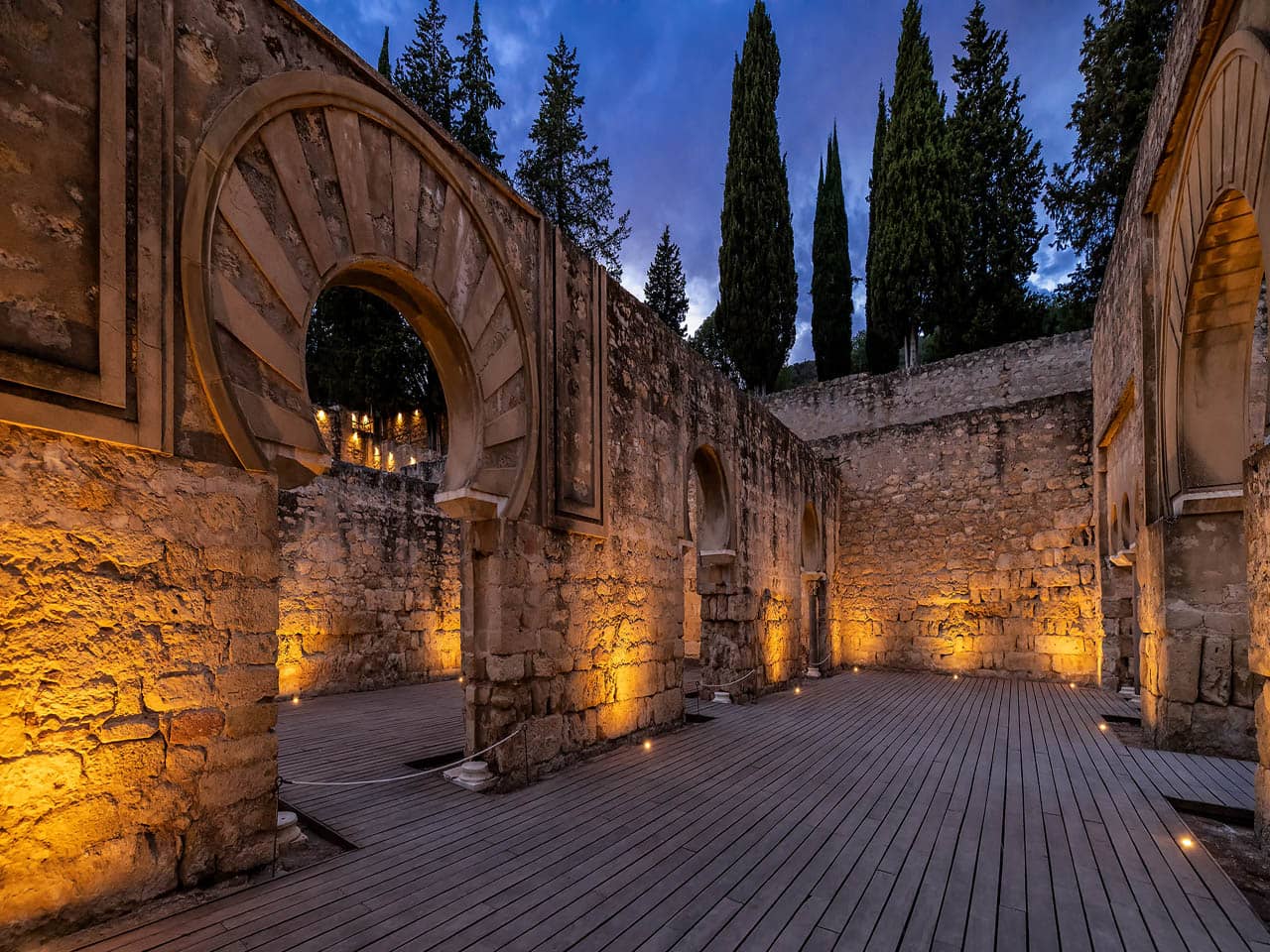
We adore this place. We know how to extract its magic and bring you back to its original era. You can go by bus or car—but at the parking area, first orient yourself. There’s a semi‑buried visitor center for tickets. Then you ascend to see the true city. The process is tricky alone, but on our Medina Azahara Tour, we handle everything—bus pickup in Córdoba, a three‑hour guaranteed enjoyment, and return drop‑off.
Medina Azahara—the Bright City, 10th‑century Córdoba’s Versailles—built by Caliph Abd al‑Rahman III and birthplace of subsequent caliphs.
The cradle of arts, sciences, and innovation in the West, an impregnable city reflecting its immense power.
The caliphal court moved here, making it the Western world’s nerve center in the 10th century. Its history, anecdotes, incredible photo ops, and an unforgettable experience await you on our guided route: daily life, protocols, architecture, art, romances, betrayals—light and shadow woven into every stone.
Open year‑round, with summer night tours. If I had to pick one must‑see beyond the Mosque, Medina Azahara is a sure bet.
Jewish Quarter of Córdoba
Back in the city, another iconic spot is the Medieval Jewish Quarter.
Wandering its labyrinthine lanes isn’t stressful—it’s part of the experience. This century‑old quarter blends narrow, winding streets with the oldest synagogue in Europe.
It’s smaller than many imagine—people often think the Jewish Quarter surrounds the Mosque, but originally it was just about ten streets where Córdoba’s Jews lived from the 13th to the 15th century, until their expulsion.
The quarter is full of contrasts and uniqueness.
The centerpiece is the Synagogue. One of only three medieval synagogues remaining in Spain, with original decoration and structure intact—an intimate, fascinating place.
There’s more: the Taurine Museum in Casa de las Bulas, the Casa Sefarad showcasing Sephardic life, and a bronze statue of famed Córdoba Jew Maimonides on Calle Judíos—an essential stop.
The Municipal Crafts Market, the Mudejar Chapel of San Bartolomé, and Calleja del Salmorejo are other must‑sees. And of course, souvenir shops, bars, and restaurants complete the Jewish Quarter experience.
Alcázar of the Christian Monarchs
Leaving the Jewish Quarter heading south—past Almedina restaurant—you descend toward the Alcázar of the Christian Monarchs. This fortress stands on millenary ground: from a Roman customs post and an early emiral alcázar to the residence of Isabella, Ferdinand, and even a prison.
The Alcázar comprises halls, towers, gardens, and baths inspired by hammams. Each area has its stories. Though centuries and civilizations overlap in its walls, the fortress retains a special allure.
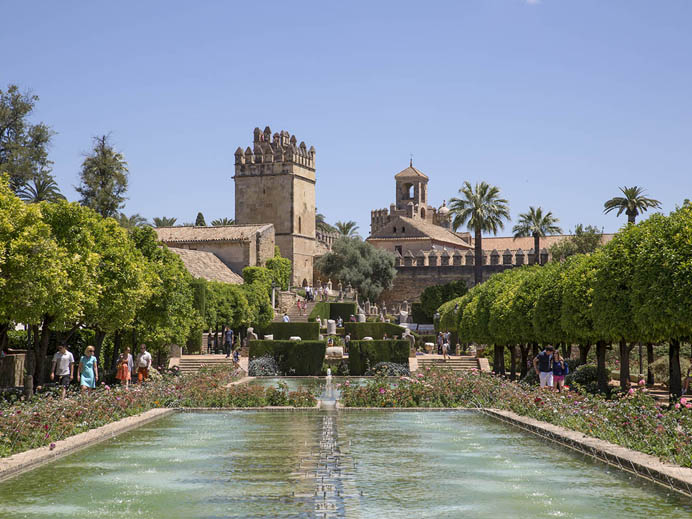
The Mosaic Hall displays original 3rd–4th century Roman mosaics in perfect condition. Initially a chapel, today it hosts exhibitions, lectures, and weddings.
Climbing the towers rewards you with fantastic views—and a mini core workout if you skip the gym! Then come the gardens: mostly Versailles‑style recreations from the 1980s, they astonish all who enter. Meticulously cared for year‑round, they burst with seasonal blooms. Fountains, scents, and even occasional wildlife perfectly complement the royal complex’s exteriors.
Experience it on our Alcázar Tour—or for adventurers, our “Córdoba In‑Depth Tour,” a four‑hour intensive covering Mosque–Cathedral, Jewish Quarter, Mudejar Chapel, and Alcázar in one morning.
Popular Patios of Córdoba
Just one street from the Alcázar lies one of Córdoba’s most authentic neighborhoods: Alcázar Viejo (San Basilio). A place full of history and rare charm.
On tours there, I always say: close your eyes and you’d think you’re in a small village stuck in the early 20th century—architecture, atmosphere, community. Many say it feels like stepping back in time—and that’s exactly what we aim to share.
We chose this quarter for our Patios Tour because San Basilio lets us—figuratively—stop time. These traditional courtyard homes have survived centuries of communal living, once common worldwide but now rare. Córdoba still offers this opportunity.
San Basilio and its famed patios explain why the Cordoban Patios Festival earned UNESCO Intangible Cultural Heritage status in 2012—and every visitor leaves enchanted.
These patios are lived in by neighbors who maintain tradition—not hired gardeners—turning each space into a lush private garden year‑round. Doubters ask if patios are worth seeing in winter or summer. My answer: absolutely. Off‑season, their green, vibrant life surpasses expectations, delighting visitors who imagine dry, dull courtyards.
Patios embody Córdoba’s centuries‑old flower‑cult tradition, alive today. If you visit, don’t skip this experience.

These homes aren’t static exhibits but living traditions, preserved by residents who nurture every bloom. They become botanical experts to keep these courtyards in perpetual splendor. As I say: all patios share a structure, but each is unique. Visiting them is a memorable highlight—patios symbolize Córdoba’s floral passion and communal heritage.
Roman Bridge & Monumental Riverside
Go online and search “Córdoba,” and you’ll see the same image: from the river’s south bank looking north—the Calahorra Tower in the foreground, the Roman Bridge linking both banks, Puerta del Puente, and the grand Mosque beyond.
The Roman Bridge and its surroundings form one of the first impressions visitors get—and it’s a key Historic Centre landmark. Plaza del Triunfo serves as a tourism hub, nestled between Puerta del Puente and the Mosque—also a favorite free tour meeting point.
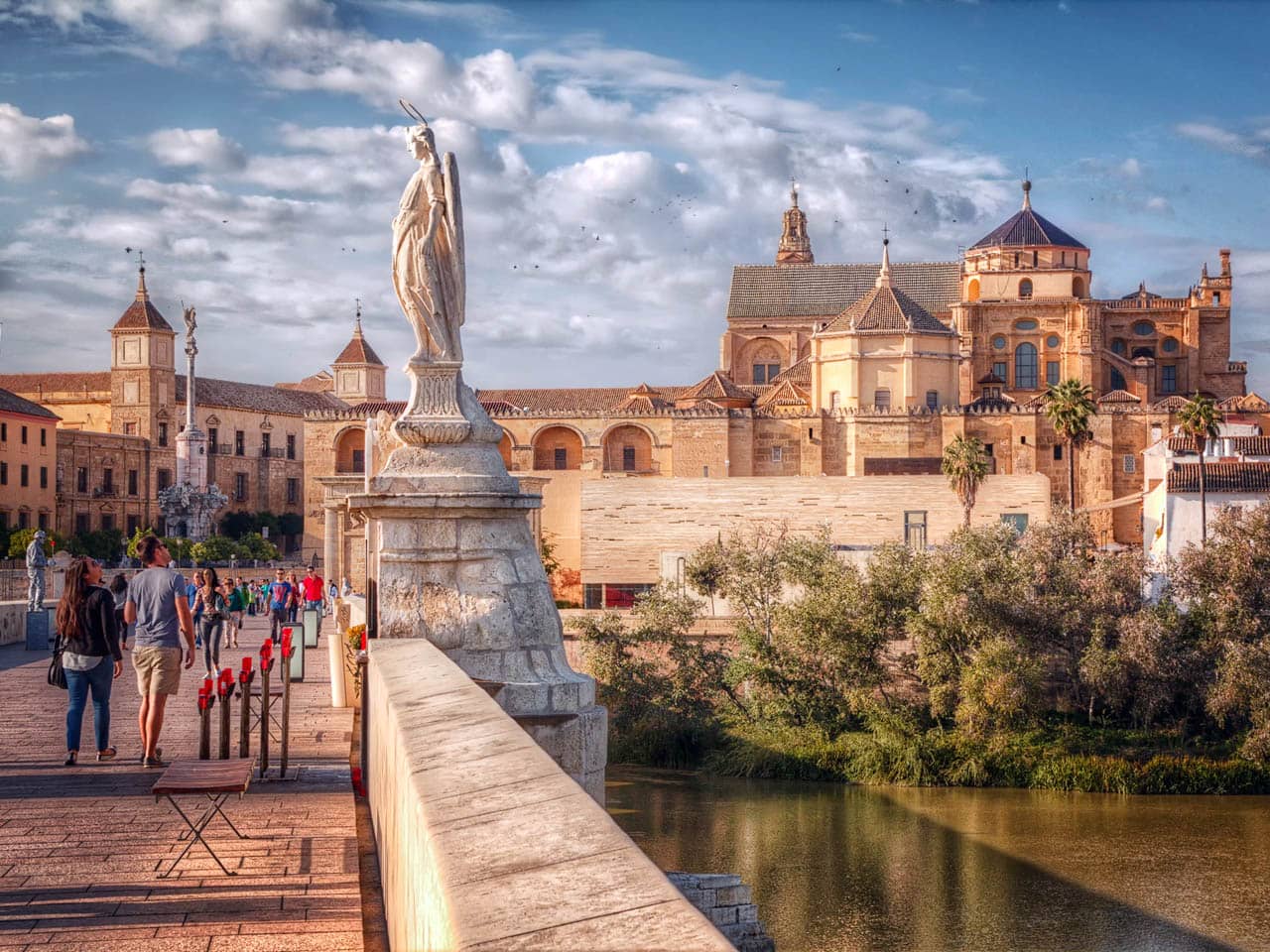
From the plaza, you enjoy a panoramic view: Mosque to the north; Puerta del Puente, Roman Bridge, mills, and waterwheel on the river south; Alcázar and San Basilio quarter to the west; and the Axerquía zone to the east.
Also in the plaza stands one of the Triumphs of Saint Raphael—a series of angelic sculptures across Córdoba.
Saint Raphael, the archangel and city’s guardian, is such an icon many mistakenly call him the city’s patron.
This largest Triumph marks our Monumental Free Tour’s start point here. The tour covers the Mosque vicinity and the Axerquía quarter over two hours—by day—revealing Córdoba’s Historic Centre.
What to See in Córdoba by Day?
Of course you can see everything day or night, but let’s be practical: daylight shows off monuments and sunsets, and you avoid summer heat. So I’ll recommend what to see or postpone by season.
A daytime stroll through the Historic Centre is invaluable. Even if you plan your own route, you’ll enjoy the charm—but our Historic Centre Free Tour ensures you hit the highlights and hidden gems.
We explore Mosque surroundings, enchanting alleys like Calleja de las Flores and Calleja del Pañuelo—popular but tricky to find without a guide. Then onto Plaza del Potro (once a medieval livestock fair square, now Flamenco Interpretation Center with free live concerts) and five minutes on to Plaza de la Corredera—a true Castilian‑style main square where a café con leche is a must-drink at budget prices.

Remember: early morning and late afternoon offer the best temperatures and light in summer. Other seasons are mild—any daylight hour works for wandering Córdoba.
What to See in Córdoba by Night?
We run evening tours year‑round, but summer adds our Night Medina Azahara Tour (Tue–Sat).
Some prefer cities at night—for the cooler air, tranquility, and enchanting illumination that transforms the cityscape.
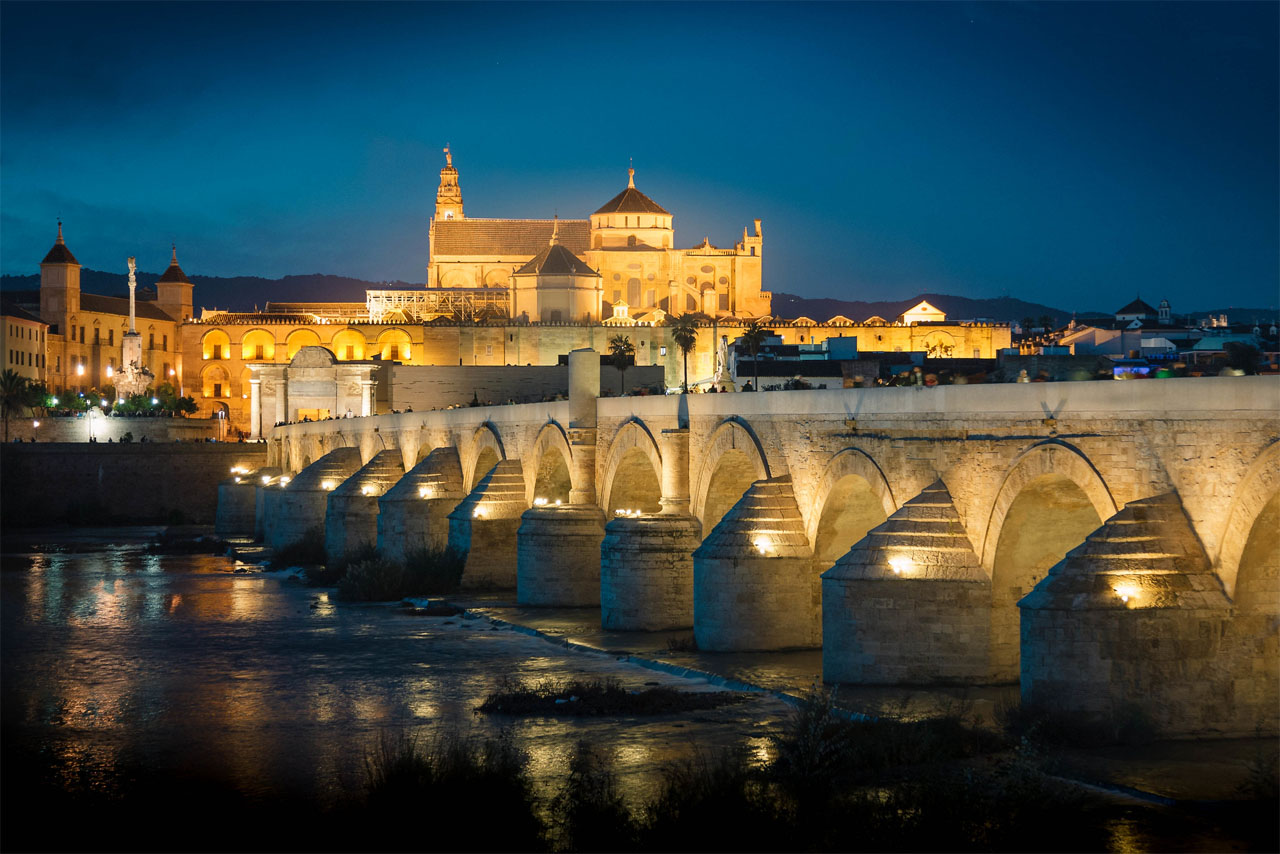
I often recommend a riverside stroll—cross the Roman Bridge to the Mosque side, past candlelit Saint Raphael statues. At the bridge’s end, circle the Calahorra Tower to the right for one of Córdoba’s most striking night views: the bridge, gate, and Mosque magnificently lit.
Another highlight is Calle Qairuán, along the west wall of the Jewish Quarter. Fragrant night‑blooming jasmine and oleander, warm lamps, and reflections in the pools create a five‑sensory experience between Seneca’s and Averroes’s statues.
Córdoba: A City You Can’t Miss
If a Cordoban caliph could grant me one wish, it’d be to see Córdoba through the eyes of every first‑time visitor. Although I’m a guide, I’m also a tourist in my own land—and elsewhere—passionate about uncovering each place’s charms. Luckily, I’m Cordoban—but sadly, I can’t rediscover it for the first time. So I relish showing its wonders to privileged newcomers.
I confess: I’m in love with a city whose millenary buildings tell their stories; whose flavors etch themselves on your palate, making you order salmorejo and oxtail again and again; whose traditions spill over walls with vivid flower‑filled patios and unforgettable scents; whose people will gladly help and even escort a lost visitor home—it’s that welcoming.
Art, life, tradition, history—dreams of caliphs etched in streets and hearts—Córdoba is plain yet royal, Moorish, Christian, and Jewish. As the band Medina Azahara sings, “He who comes never leaves.”
